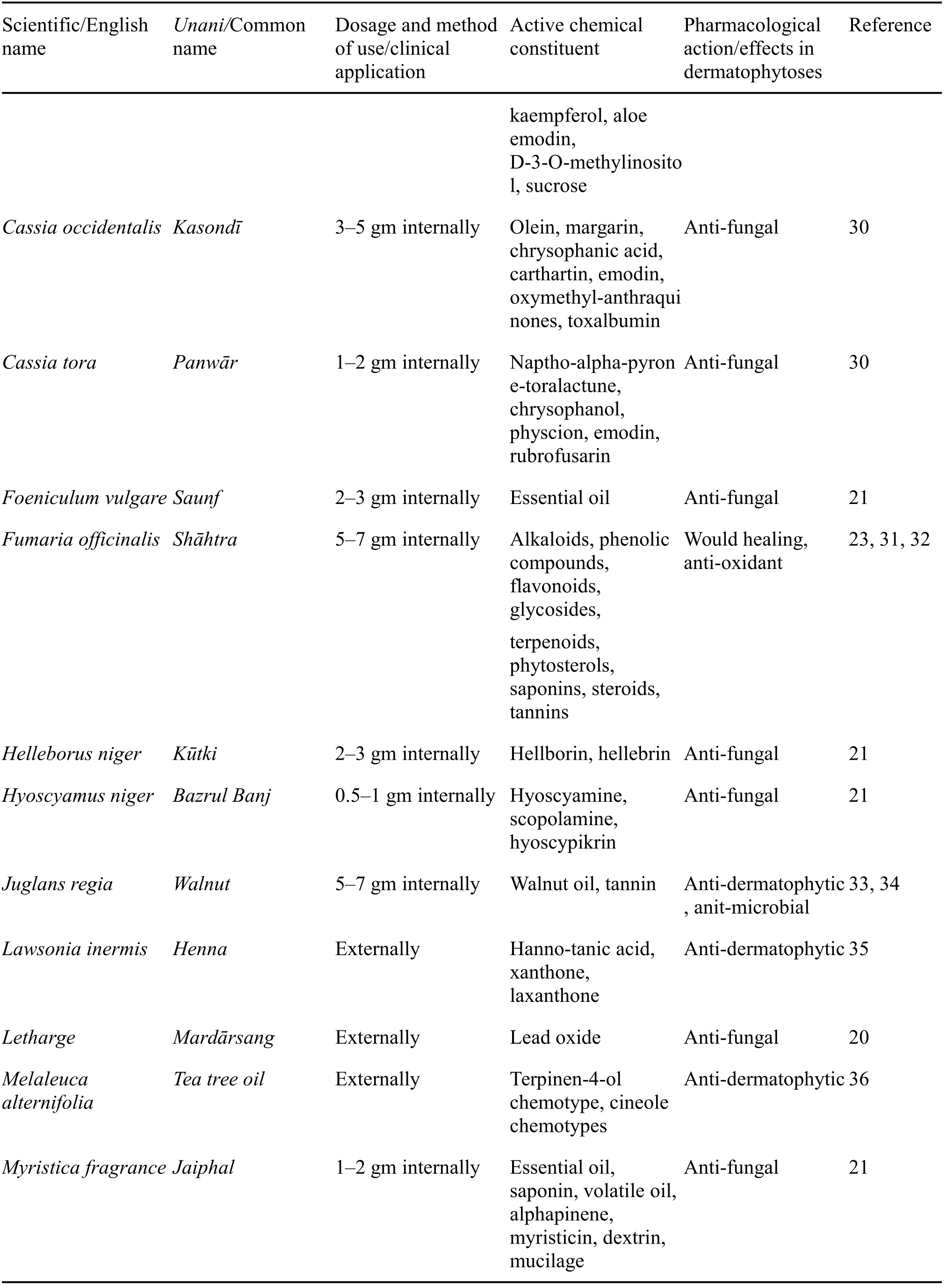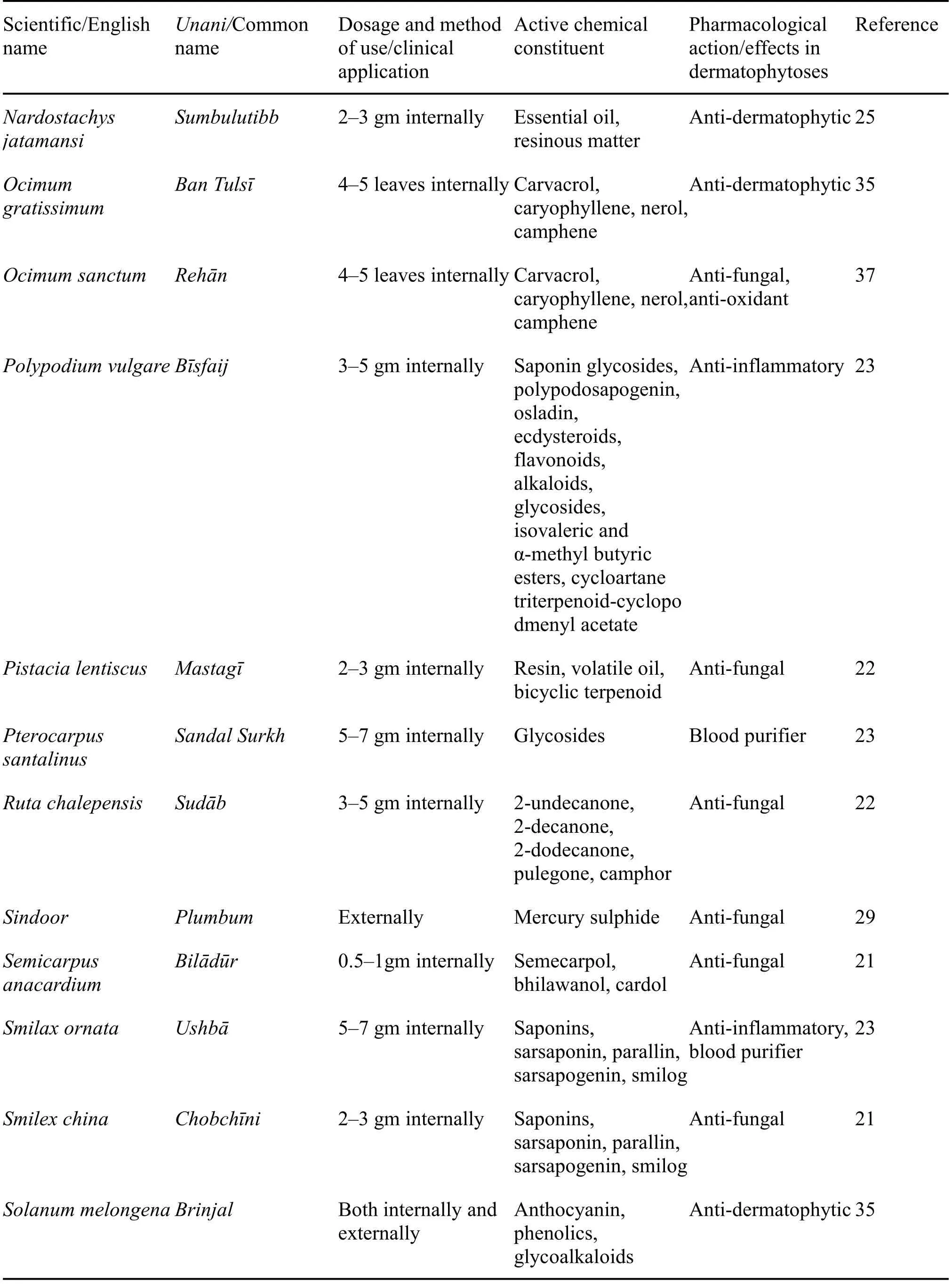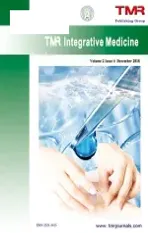Anti-fungal potency of some Unani drugs in the treatment of dermatophytoses(Qūba)
2021-02-24AdnanMastan
Adnan Mastan
1Department of Unani,All India Institute of Medical Sciences,Raipur(C.G.),India.
Abstract Qūba (dermatophytoses) is a clinical condition caused by fungal infection of skin in humans.The fungi that cause dermatophytoses feed on keratin, the material found in the outer layer of skin, hair and nails.Many effective synthetic antifungal drugs have been discovered for the treatment of dermatomycoses but their use has remained limited due to various side effects on human systems.Herbal remedies are being used for its treatment. Unani medicines are also being promoted as dermatophytoses treatment.Detailed management consisting of single herbs and compound formulations along with other regimes has been mentioned to treat this disease in the classical Unani literature, which is safe and effective.The aim of this study was to systematically review the evidence for this notion and to discuss different aspects of Qūba (dermatophytoses).Extensive literature searches were carried out to identify drugs reported to be effective in the treatment of Qūba (dermatophytoses).In this review paper author has tried to present few Unani medicines prevalently used for treatment of dermatophytoses.
Keywords:Dermatophytoses,Dermatophytes,Qūba,Unani medicine,Herbal medicine
Background
Dermatophytes are fungi which have the capability to invade keratinized regions such as skin, hair, and nails of human beings and animals, causing disease known as dermatophytoses or dermatomycoses [1].These fungi are categorized into three genera, viz:Microsporum,Trichophyton and Epidermophyton.The superficial mycotic infections had risen to such a level that skin mycoses now affect more than 20%-25% of globe population [2, 3] making them one of the most frequent form of infections [4, 5].The incidence of dermatomycoses has increased many folds in recent years because of the increase in number of immunocompromised hosts and environmental agents[6].A typical lesion of tinea is an arcuate or annular plaque which spreads centrifugally.The edge is active,showing papulo-vesiculation, pustulations and scaling while center is relatively clear (Figure 1) [7].Dermatophytoses is classified according to the site of affection such as tinea capitis (head), tinea barbae(beard), tinea facei (face), tinea corporis (body), tinea inguinalis or cruris (groin), tinea manus (hands), tinea pedis (foot), tinea unguim (nails) [8, 9].Predisposing factors for the disease are skin trauma, hydration state of macerated skin, occlusion, elevated temperature and humidity along with the state of host defenses.Some effective synthetic antifungal drugs have been discovered for the treatment of dermatomycoses but their use has remained limited due to various side effects on human systems [10-12].Amphotericin-B and nystatin, both antifungal agents which are frequently used as chemotherapeutic agents, also have some side effects [13].Unanimedicine provides a successful treatment for many skin diseases.Several medications have been reported to be safe and effective inQūba(dermatophytoses).Hence, attempt has been made through this review paper to presentQūba(dermatophytoses) in view ofUnanimedicine and review theUnanidrugs reported to be effective in the treatment of dermatophytoses.
Methods
The author searched theUnanimedicine books such asAl-Qānūn fiʹl Ṭibb(the Canon of Medicine) of Ibne Sīnā,Al-Muʹālajāt al-Buqrāṭiyya(Hipporatic Medicine)of Abuʹl Ḥasan ibn Muḥammad Ṭabrī,Kitāb al-Ḥāwī(The Comprehensive book of medicine) of Zakariya Rāzī,Ḍakhīrā Khawārizm Shāhī(Treasure dedicated to the king of Khawārizm) of Ismāʹīl Jurjānī,Khazāʹin al-Adwiya(treasure of medicinal drugs) of Najmul Ghanī etc.for information onQūba(dermatophytosis)andUnanidrugs.Search was also carried out on scientific databases like Pubmed, Science Direct and Springer.The search words used were “Qūbaand dermatophytoses”, “dermatophytoses andUnani”,“Herbal Medicines and dermatophytoses”.Other sources on internet such as Google Scholar and other search engines were also used to find evidence regarding efficacy ofUnanidrugs in the management of dermatophytoses.
Results and discussion
InUnaniliterature disease has been delineated in detail,Zakariya Rāzī (850-923 B.C.E), an eminentUnaniphysician describedQūba(dermatophytoses) as a skin disease which is characterized by dryness and scaling,sometimes vesicle formation associated with intense itching and burning [14].Ibne Sīnā (980-1037 B.C.E)described the disease as blisters having itching,irritation and burning [15].Countless supplementary words have additionally been utilized for this illness e.gKaryūn, DaryūnandDādd[16].InUnanisystem of medicine, the principle of treatment is aimed at the alteration or removal of morbid material, which is the main culprit for the genesis of pathology leading to development of disease [16-18].Many ancient healers have recommended drugs possessingMuṣaff-i Dam(blood purifier) andMudammil Qurūḥ(healing)properties for the treatment of theQūba(dermatophytoses) [19].The drugs endowed with such properties seem to have the potential to counteract the underlying pathology.Thus,Muṣaffi(purifying) effect may selectively negotiate with the morbid material,either by neutralizing or removing it; whileMudammil(healing) effect may promote the healing once the morbid matter is removed from the body,inflammation is resolved; proper healing takes place and chances of recurrence minimize automatically.Along with oral use of drugs,Unaniphysicians have given great emphasis on the topical treatment in the form ofḌimād(paste),Ṭilāʹ(liniment)andMarham(ointment)[18].
Drugs with efficacy in Qūba(dermatophytoses)
Many drugs are being used inUnanisystem of medicine for treatment ofQūba(dermatophytoses).Therefore, drugs that are used and those reported in research studies to be effective in the treatment of dermatophytoses are summarized in Table 1.

Table 1 Unani drugs effective in the treatment of dermatophytosis

Table 1 Unani drugs effective in the treatment of dermatophytosis(continued)

glucopyranoside,?

Table 1 Unani drugs effective in the treatment of dermatophytosis(continued)

Table 1 Unani drugs effective in the treatment of dermatophytosis(continued)

Table 1 Unani drugs effective in the treatment of dermatophytosis(continued)
There is a treasure trove of medicines in theUnanisystem of medicine for many diseases which are still unexplored.Dermatophytoses is as such disease where manyUnanidrugs are being reported to be effective in its treatment.These drugs include both herbal and mineral origin drugs as presented in Table 1.Medicines that are very commonly used in the treatment are Sulphur,Borax,Cinnamomum comphora,Letharge,Azadirachta indica, Cocos nucifera, Cassia tora, Fumaria officinalis, Pterocarpus santalinus,Sphaeranthus indicus, Swertia chirata, Tephrosia purpurea.Author has also conducted clinical trials using these drugs and reported their efficacy and safety in the treatment of dermatophytosis[49].
Conclusion
Dermatophytoses is very common among the population.Synthetic drugs have been reported to be associated with side effects during the treatment of dermatophytoses, so alternative & herbal medicines with favorable safety profiles is the best approach for treatment of dermatophytoses.Unanimedicine provides a safe and effective treatment in this regard.Evidence from sufficient clinical trials is encouraging regarding efficacy ofUnanidrugs in the treatment of dermatophytosis.However,further research is required to establish their efficacy and safety on a larger scale with multi-centric clinical trials.
